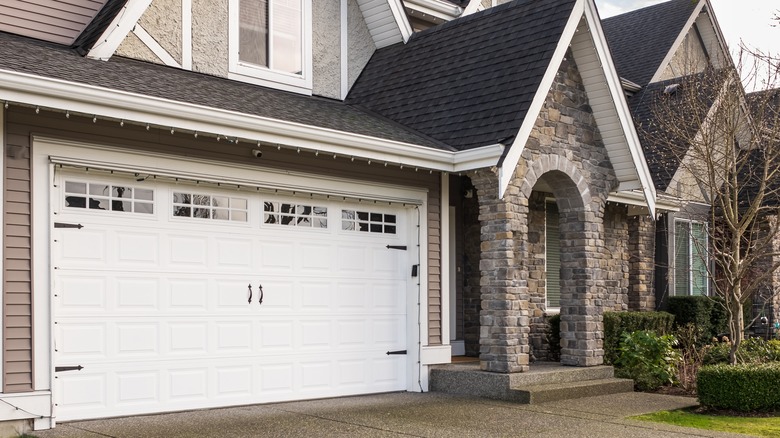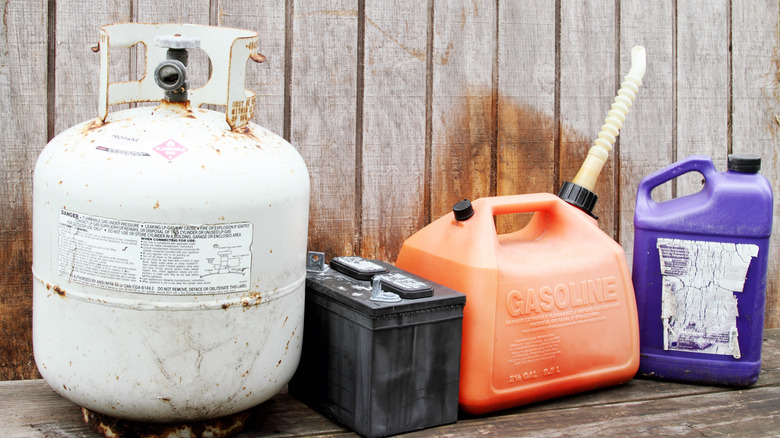Why Your Garage Might Not Be The Best Place To Store Spare Batteries
You've bought all the chargers and lined them up nicely in a DIY charging station. You spend absurd amounts on spares, even when you find a sale. And you're careful to keep the seasonal batteries — for lawnmowers and the like — half-charged during storage months. Now, as if batteries weren't challenging enough, they want a heated and air-conditioned room, and a nice quilt would be nice too. Power tool and other lithium battery users who pay attention to such things (and thought they were doing everything right) are starting to realize that their pricey batteries don't have the lifespan they should because they're being stored in a garage that swings between freezing in winter and sweltering in summer. But before you have your kids share a room so your batteries have a comfy place to lounge, let's take a closer look at the problem.
Lithium batteries are pretty robust, especially compared to earlier generations of tool batteries like nickel-cadmium (Ni-Cd) or nickel metal hydride (NiMH) batteries. This includes both major varieties, lithium-ion cells with hard protective cases (like the cells that are likely inside your drill batteries) and lithium polymer (Li-Po) batteries in squishy foil packages found in many rechargeable devices. But they do have some temperature requirements, and since they tend to be obscenely expensive it's probably a good idea to tune in to those needs.
What are the ideal storage conditions?
We tend to keep our batteries in places like garages and workshops because that's where the devices they power are stored or used. You don't want to be tromping through the house to the battery storage closet every time you need a battery for the weed trimmer. But it might be the best place for your batteries unless you have a particularly luxe garage with heat, air conditioning, and insulation and you don't mind paying for all three. This is because the ideal storage location for lithium batteries is a place with a consistent temperature somewhere in the 35 to 90° range.
Batteries are unlikely to suffer any substantial damage from exposure to low or high temperatures unless those temperatures are extreme... say, below 20 or over 100° zones. The effects of cold are a temporary reduction in capacity as the chemical processes within the battery slow. Heat can be more of a problem since it's possible to trigger thermal runaway — a condition in which the battery or tool's heat dissipation mechanisms can't keep up with the temperature increase. This could be catastrophic, resulting in fire or explosion, but the risk is very low at around one 10,000th of a percent for a single Li-Ion cell. However, storage temperature is only a minor cause of thermal runaway, along with cell quality, onboard over-charge protection, over-discharge protection, and most importantly, thermal protection.
Let's get real about garage storage
As anyone who's driven lag bolts long enough with a decent drill knows, when the drill battery begins to overheat, the device will shut off. That's the thermal protection circuit of the battery management system in action. And thank goodness for that, because very few people actually follow the expert guidance on rechargeable toys and other battery-operated, common items you should avoid putting in your trash can... and lithium batteries are a common source of fires in waste management facilities.
It seems unlikely that DIYers are going to stop storing their batteries in workshops and garages, and even more unlikely that tradespeople will keep their batteries air-conditioned on a hot job site in Texas. It seems even less likely that tools and other devices with built-in lithium batteries — wall clocks, screwdrivers, radio-control cars, wireless earbuds, every toy imaginable, lawnmowers, and this gadget that opens and closes your curtains automatically — will be collected at the end of the day and deposited in your daughter's old bedroom for a climate-controlled rest and recharge. The good news is that if your garage is at a reasonable temperature for you to work in without endangering yourself — say, 35-90 degrees — your batteries will be fine. And if it's not, it's easy enough to learn how to cool a garage in summer and how to warm up your garage during freezing cold winters.


